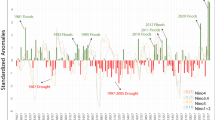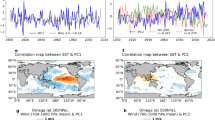Abstract
A significant reduction in summer monsoon rainfall has been observed in northern central India during the second half of the twentieth century, threatening water security and causing widespread socio-economic impacts. Here, using various observational data sets, we show that monsoon rainfall has increased in India at 1.34 mm d−1 decade−1 since 2002. This apparent revival of summer monsoon precipitation is closely associated with a favourable land–ocean temperature gradient, driven by a strong warming signature over the Indian subcontinent and slower rates of warming over the Indian Ocean. The continental Indian warming is attributed to a reduction of low cloud due to decreased ocean evaporation in the Arabian Sea, and thus decreased moisture transport to India. Global climate models fail to capture the observed rainfall revival and corresponding trends of the land–ocean temperature gradient, with implications for future projections of the Indian monsoon.
This is a preview of subscription content, access via your institution
Access options
Access Nature and 54 other Nature Portfolio journals
Get Nature+, our best-value online-access subscription
$29.99 / 30 days
cancel any time
Subscribe to this journal
Receive 12 print issues and online access
$209.00 per year
only $17.42 per issue
Buy this article
- Purchase on SpringerLink
- Instant access to full article PDF
Prices may be subject to local taxes which are calculated during checkout





Similar content being viewed by others
References
Auffhammer, M., Ramanathan, V. & Vincent, J. R. Climate change, the monsoon, and rice yield in India. Clim. Change 111, 411–424 (2012).
Lobell, D. B., Schlenker, W. & Costa-Roberts, J. Climate trends and global crop production since 1980. Science 333, 616–620 (2011).
Ray, D. K., Gerber, J. S., MacDonald, G. K. & West, P. C. Climate variation explains a third of global crop yield variability. Nat. Commun. 6, 5989 (2015).
Wheeler, T. & von Braun, J. Climate change impacts on global food security. Science 341, 508–513 (2013).
Wada, Y., van Beek, L. P. H. & Bierkens, M. F. P. Modelling global water stress of the recent past: on the relative importance of trends in water demand and climate variability. Hydrol. Earth Syst. Sci. 15, 3785–3808 (2011).
Chung, C. E. & Ramanathan, V. Weakening of North Indian SST gradients and the monsoon rainfall in India and the Sahel. J. Clim. 19, 2036–2045 (2006).
Roxy, M. K. et al. Drying of Indian subcontinent by rapid Indian Ocean warming and a weakening land-sea thermal gradient. Nat. Commun. 6, 7423 (2015).
Paul, S. et al. Weakening of Indian summer monsoon rainfall due to changes in land use land cover. Sci. Rep. 6, 32177 (2016).
Bollasina, M. A., Ming, Y. & Ramaswamy, V. Anthropogenic aerosols and the weakening of the South Asian summer monsoon. Science 334, 502–505 (2011).
Ramanathan, V. et al. Atmospheric brown clouds: impacts on South Asian climate and hydrological cycle. Proc. Natl Acad. Sci. USA 102, 5326–5333 (2005).
Asoka, A., Gleeson, T., Wada, Y. & Mishra, V. Relative contribution of monsoon precipitation and pumping to changes in groundwater storage in India. Nat. Geosci. 10, 109–117 (2017).
Kajikawa, Y., Yasunari, T., Yoshida, S. & Fujinami, H. Advanced Asian summer monsoon onset in recent decades. Geophys. Res. Lett. 39, L03803 (2012).
Krishnamurti, T. N. Summer monsoon experiment—a review. Mon. Weath. Rev. 113, 1590–1626 (1985).
Luo, H. B. & Yanai, M. The large-scale circulation and heat-sources over the Tibetan plateau and surrounding areas during the early summer of 1979. Part 1: precipitation and kinematic analyses. Mon. Weath. Rev. 111, 922–944 (1983).
Murakami, T. & Ding, Y. H. Wind and temperature–changes over Eurasia during the early summer of 1979. J. Meteorol. Soc. Jpn 60, 183–196 (1982).
Webster, P. J. In Monsoons 3–32 (John Wiley, 1987).
Young, J. A. In Monsoons 211–243 (John Wiley, 1987).
Zhang, Z. Q., Chan, J. C. L. & Ding, Y. H. Characteristics, evolution and mechanisms of the summer monsoon onset over Southeast Asia. Int. J. Climatol. 24, 1461–1482 (2004).
Fu, C. & Fletcher, J. O. The relationship between Tibet–Tropical Ocean thermal contrast and interannual variability of Indian monsoon rainfall. J. Clim. Appl. Meteorol. 24, 841–847 (1985).
Li, C. F. & Yanai, M. The onset and interannual variability of the Asian summer monsoon in relation to land sea thermal contrast. J. Clim. 9, 358–375 (1996).
Meehl, G. A. Influence of the land-surface in the Asian summer monsoon—external conditions versus internal feedbacks. J. Clim. 7, 1033–1049 (1994).
England, M. H. et al. Recent intensification of wind-driven circulation in the Pacific and the ongoing warming hiatus. Nat. Clim. Change 4, 222–227 (2014).
Trenberth, K. E. & Fasullo, J. T. An apparent hiatus in global warming? Earths Future 1, 19–32 (2013).
Roxy, M. K., Ritika, K., Terray, P. & Masson, S. The curious case of Indian Ocean warming. J. Clim. 27, 8501–8509 (2014).
Park, I. H., Min, S. K., Yeh, S. W., Weller, E. & Kim, S. T. Attribution of the 2015 record high sea surface temperatures over the central equatorial Pacific and tropical Indian Ocean. Environ. Res. Lett. 12, 044024 (2017).
Su, J. Z., Zhang, R. H. & Wang, H. J. Consecutive record-breaking high temperatures marked the handover from hiatus to accelerated warming. Sci. Rep. 7, 43735 (2017).
Dai, A. G. et al. The relative roles of upper and lower tropospheric thermal contrasts and tropical influences in driving Asian summer monsoons. J. Geophys. Res. 118, 7024–7045 (2013).
Lau, K. M., Kim, M. K. & Kim, K. M. Asian summer monsoon anomalies induced by aerosol direct forcing: the role of the Tibetan Plateau. Clim. Dynam. 26, 855–864 (2006).
Wu, G. X. et al. Thermal controls on the Asian summer monsoon. Sci. Rep. 2, 00404 (2012).
Solomon, S. et al. Contributions of stratospheric water vapor to decadal changes in the rate of global warming. Science 327, 1219–1223 (2010).
Yu, R. C., Wang, B. & Zhou, T. J. Tropospheric cooling and summer monsoon weakening trend over East Asia. Geophys. Res. Lett. 31, L22212 (2004).
Taylor, K. E., Stouffer, R. J. & Meehl, G. A. An overview of CMIP5 and the experiment design. Bull. Am. Meteorol. Soc. 93, 485–498 (2012).
Salzmann, M. & Cherian, R. On the enhancement of the Indian summer monsoon drying by Pacific multidecadal variability during the latter half of the twentieth century. J. Geophys. Res. 120, 9103–9118 (2015).
Gimeno, L., Drumond, A., Nieto, R., Trigo, R. M. & Stohl, A. On the origin of continental precipitation. Geophys. Res. Lett. 37, L13804 (2010).
Wei, J. F., Su, H. & Yang, Z. L. Impact of moisture flux convergence and soil moisture on precipitation: a case study for the southern United States with implications for the globe. Clim. Dynam. 46, 467–481 (2016).
Boucher, O. et al. in Climate Change 2013: The Physical Science Basis (eds Stocker, T. F. et al.) 571–657 (IPCC, Cambridge Univ. Press, 2013).
Jin, Q., Wei, J. & Yang, Z. L. Positive response of Indian summer rainfall to Middle East dust. Geophys. Res. Lett. 41, 4068–4074 (2014).
Jin, Q., Wei, J., Yang, Z. L., Pu, B. & Huang, J. Consistent response of Indian summer monsoon to Middle East dust in observations and simulations. Atmos. Chem. Phys. 15, 9897–9915 (2015).
Jin, Q., Yang, Z.-L. & Wei, J. Seasonal responses of Indian summer monsoon to dust aerosols in the Middle East, India, and China. J. Clim. 29, 6329–6349 (2016).
Ackerman, A. S. et al. Reduction of tropical cloudiness by soot. Science 288, 1042–1047 (2000).
Bollasina, M., Nigam, S. & Lau, K. M. Absorbing aerosols and summer monsoon evolution over South Asia: an observational portrayal. J. Clim. 21, 3221–3239 (2008).
Koren, I., Kaufman, Y. J., Remer, L. A. & Martins, J. V. Measurement of the effect of Amazon smoke on inhibition of cloud formation. Science 303, 1342–1345 (2004).
Lee, S. Y., Shin, H. J. & Wang, C. Nonlinear effects of coexisting surface and atmospheric forcing of anthropogenic absorbing aerosols: impact on the South Asian monsoon onset. J. Clim. 26, 5594–5607 (2013).
Lee, S. Y. & Wang, C. The response of the South Asian summer monsoon to temporal and spatial variations in absorbing aerosol radiative forcing. J. Clim. 28, 6626–6646 (2015).
Yu, H. B., Liu, S. C. & Dickinson, R. E. Radiative effects of aerosols on the evolution of the atmospheric boundary layer. J. Geophys. Res. 107, AAC3-1–AAC3–14 (2002).
Ratnam, J. V., Behera, S. K., Ratna, S. B., Rajeevan, M. & Yamagata, T. Anatomy of Indian heatwaves. Sci. Rep. 6, 24395 (2016).
Wang, B. et al. Northern Hemisphere summer monsoon intensified by mega-El Nino/southern oscillation and Atlantic multidecadal oscillation. Proc. Natl Acad. Sci. USA 110, 5347–5352 (2013).
Harris, I., Jones, P. D., Osborn, T. J. & Lister, D. H. Updated high-resolution grids of monthly climatic observations—the CRU TS3.10 Dataset. Int. J. Climatol. 34, 623–642 (2014).
Schneider, U. et al. GPCC’s new land surface precipitation climatology based on quality-controlled in situ data and its role in quantifying the global water cycle. Theor. Appl. Climatol. 115, 15–40 (2014).
Chen, M. Y., Xie, P. P., Janowiak, J. E. & Arkin, P. A. Global land precipitation: a 50-yr monthly analysis based on gauge observations. J. Hydrometeorol. 3, 249–266 (2002).
Adler, R. F. et al. The version-2 Global Precipitation Climatology Project (GPCP) monthly precipitation analysis (1979-present). J. Hydrometeorol. 4, 1147–1167 (2003).
Huffman, G. J. et al. The TRMM Multisatellite Precipitation Analysis (TMPA): Quasi-global, multiyear, combined-sensor precipitation estimates at fine scales. J. Hydrometeorol. 8, 38–55 (2007).
Naidu, C. V. et al. Is summer monsoon rainfall decreasing over India in the global warming era? J. Geophys. Res. 114, D24108 (2009).
Rajeevan, M., Bhate, J., Kale, J. A. & Lal, B. High resolution daily gridded rainfall data for the Indian region: analysis of break and active monsoon spells. Curr. Sci. India 91, 296–306 (2006).
Rayner, N. A. et al. Global analyses of sea surface temperature, sea ice, and night marine air temperature since the late nineteenth century. J. Geophys. Res. 108, 4407 (2003).
Legates, D. R. & Willmott, C. J. Mean seasonal and spatial variability in global surface air-temperature. Theor. Appl. Climatol. 41, 11–21 (1990).
Kalnay, E. et al. The NCEP/NCAR 40-year reanalysis project. Bull. Am. Meteorol. Soc. 77, 437–471 (1996).
Kato, S. et al. Surface irradiances consistent with CERES-derived top-of-atmosphere shortwave and longwave irradiances. J. Clim. 26, 2719–2740 (2013).
Wielicki, B. A. Clouds and the Earth’s Radiant Energy System (CERES): an Earth observing system experiment. Bull. Am. Meteorol. Soc. 77, 1590 (1996).
Rienecker, M. M. et al. MERRA: NASA’s modern-era retrospective analysis for research and applications. J. Clim. 24, 3624–3648 (2011).
Acknowledgements
This study was supported by the US National Science Foundation (AGS-1339264), US DOE (DE-FG02-94ER61937), and the National Research Foundation (NRF) of Singapore to the Center for Environmental Sensing and Modeling (CENSAM) of the Singapore-MIT Alliance for Research and Technology (SMART) centre. We acknowledge the World Climate Research Programme’s Working Group on Coupled Modelling, which is responsible for CMIP, and we thank the climate modelling groups for producing and making their model output available. For CMIP the US Department of Energy’s Program for Climate Model Diagnosis and Intercomparison provides coordinating support and led development of software infrastructure in partnership with the Global Organization for Earth System Science Portals. We truly appreciate the efforts of various responsible groups for making their observational or reanalysis data publicly available. We also thank D. Rothenberg for providing scripts to download the CMIP5 data and his valuable comments on this work.
Author information
Authors and Affiliations
Contributions
Q.J. and C.W. designed analysis strategy, Q.J. performed data analyses, Q.J. and C.W. wrote the paper.
Corresponding author
Ethics declarations
Competing interests
The authors declare no competing financial interests.
Supplementary information
Supplementary Information
Supplementary Information (PDF 7052 kb)
Rights and permissions
About this article
Cite this article
Jin, Q., Wang, C. A revival of Indian summer monsoon rainfall since 2002. Nature Clim Change 7, 587–594 (2017). https://doi.org/10.1038/nclimate3348
Received:
Accepted:
Published:
Issue Date:
DOI: https://doi.org/10.1038/nclimate3348



